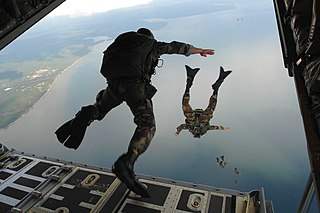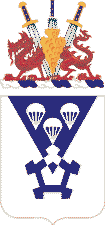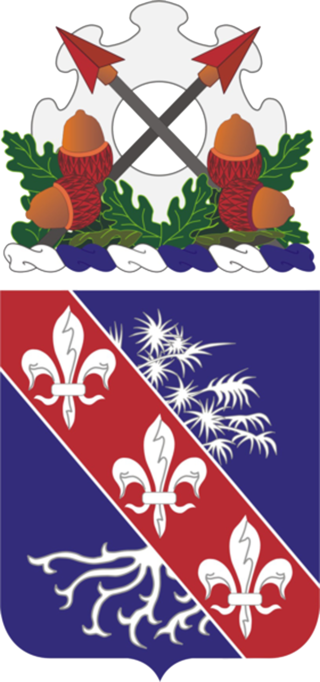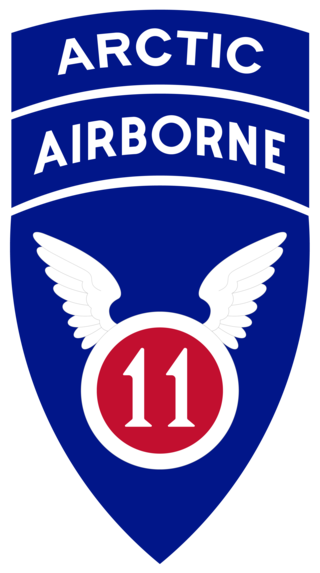
Airborne forces are ground combat units carried by aircraft and airdropped into battle zones, typically by parachute drop. Parachute-qualified infantry and support personnel serving in airborne units are also known as paratroopers.

The 101st Airborne Division (Air Assault) ("Screaming Eagles") is a light infantry division of the United States Army that specializes in air assault operations. It can plan, coordinate, and execute brigade-sized air assault operations, within one period of darkness, up to 500 nautical miles behind enemy lines, to seize key terrain for up to 14 days. In recent years, the 101st was active in foreign internal defense and counterterrorism operations in Iraq, in Afghanistan in 2015–2016, and in Syria, as part of Operation Inherent Resolve in 2018–2021.

The 82nd Airborne Division is an airborne infantry division of the United States Army specializing in parachute assault operations into hostile areas with a U.S. Department of Defense mandate to be "on-call to fight any time, anywhere" at "the knife's edge of technology and readiness." Primarily based at Fort Liberty, North Carolina, the 82nd Airborne Division is part of the XVIII Airborne Corps. The 82nd Airborne Division is the U.S. Army's most strategically mobile division.

The 4th Infantry Division is a division of the United States Army based at Fort Carson, Colorado. It is composed of a division headquarters battalion, three brigade combat teams, a combat aviation brigade, a division sustainment brigade, and a division artillery.

The 25th Infantry Division is a United States Army division based at Schofield Barracks in Hawaii. The division, which was activated on 1 October 1941 in Hawaii, conducts military operations primarily in the Asia-Pacific region. Its present deployment is composed of light infantry and aviation units. Tropic Lightning soldiers regularly train with other U.S. military branches to practice and maintain joint operations capabilities. The climate and terrain of the Pacific region demands Tropic Lightning soldiers be able to operate in physically demanding and harsh environments. In 2014, the division opened the Jungle Operations Training Center—the first such school in the Army since the closing of the old Jungle Warfare School at Fort Sherman, Panama Canal Zone. Joint operations and training with partner states herald a new chapter in the history of Tropic Lightning—America's Pacific Division.

The 506th Infantry Regiment, originally designated the 506th Parachute Infantry Regiment during World War II, is an airborne light infantry regiment of the United States Army. Currently a parent regiment under the U.S. Army Regimental System, the regiment has two active battalions: the 1st Battalion, 506th Infantry Regiment is assigned to the 1st Brigade Combat Team, 101st Airborne Division, and the 2nd Battalion, 506th Infantry Regiment is assigned to the 3rd Brigade Combat Team, 101st Airborne Division.

In military organizations, a pathfinder is a specialized soldier inserted or dropped into place in order to set up and operate drop zones, pickup zones, and helicopter landing sites for airborne operations, air resupply operations, or other air operations in support of the ground unit commander. Pathfinders first appeared in World War II, and continue to serve an important role in today's modern armed forces, providing commanders with the option of flexibly employing air assets. There was a group of pilots who were also designated pathfinders. They flew C-47 (DC-3) aircraft and were the lead planes followed by paratroop transports, used for dropping paratroopers into designate drop zones such as on D-Day, the Normandy Invasion.

The 187th Airborne Infantry Regiment (Rakkasans) is a regiment of the 101st Airborne Division.

The 503rd Infantry Regiment, formerly the 503rd Parachute Infantry Regiment and the 503rd Airborne Infantry Regiment, is an airborne infantry regiment of the United States Army. The regiment served as an independent regiment in the Pacific War during World War II; at Fort Campbell, Kentucky; in Okinawa, Japan; and in Germany. Regimental elements have been assigned to the 2nd Infantry Division, the 11th Airborne Division, the 24th Infantry Division, 25th Infantry Division, the 82nd Airborne Division, 101st Airborne Division, and the 173rd Airborne Brigade Combat Team. Regimental elements have participated in campaigns in the Vietnam War, Operation Enduring Freedom–Afghanistan, and Operation Iraqi Freedom. The regiment claims 15 Medal of Honor recipients: two from World War II, ten from Vietnam, and three from Afghanistan. A parent regiment under the U.S. Army Regimental System. The regiment's 1st and 2nd Battalions are active, assigned to the 173rd Airborne Brigade, based at Caserma Ederle, Vicenza, Italy. The 3rd and 4th Battalions as well as Companies E, F, G, H, and I have been inactived.

The Battle of Norfolk was a tank battle fought on February 27, 1991, during the Persian Gulf War, between armored forces of the United States and United Kingdom, and those of the Iraqi Republican Guard in the Muthanna Province of southern Iraq. The primary participants were the U.S. 2nd Armored Division (Forward), 1st Infantry Division (Mechanized), and the Iraqi 18th Mechanized and 9th Armoured Brigades of the Republican Guard Tawakalna Mechanized Infantry Division along with elements from eleven other Iraqi divisions. The 2nd Armored Division (Forward) was assigned to the American 1st Infantry Division as its 3rd maneuver brigade due to the fact that one of its brigades was not deployed. The 2nd Armored Division (Forward)'s Task Force 1-41 Infantry would be the spearhead of VII Corps. The British 1st Armoured division was responsible for protecting the right flank of VII Corps, their main adversary being the Iraqi 52nd Armored Division and multiple infantry divisions. It was the final battle of the war before the unilateral ceasefire took effect.

The 509th Infantry Regiment is an airborne infantry regiment of the United States Army. The unit was initially activated as a single battalion, the 504th Parachute Infantry Battalion, in October 1941 at Fort Benning, Georgia. Nicknamed "Geronimo", the 509th conducted the U.S. Army's first combat jump during World War II on 8 November 1942, flying 1,500 miles from England to seize Tafarquay airport in Oran, Algeria. The 509th made a total of five combat jumps during the war.

The 505th Infantry Regiment, formerly and colloquially the 505th Parachute Infantry Regiment and the 505th Airborne Infantry Regiment, is an airborne infantry regiment of the United States Army, one of four infantry regiments of the 82nd Airborne Division of the United States Army, with a long and distinguished history.

The 504th Infantry Regiment, originally the 504th Parachute Infantry Regiment, is an airborne forces regiment of the United States Army, part of the 82nd Airborne Division, with a long and distinguished history. The regiment was first formed in mid-1942 during World War II as part of the 82nd Airborne Division and saw service in Sicily, Italy, Anzio, the Netherlands, Belgium and Germany.

The 327th Infantry Regiment is an infantry regiment of the 101st Airborne Division of the United States Army. During World War II, the 327th was a glider-borne regiment of the 101st Airborne Division. It fought during World War I as part of the 82nd Division. It has also been deployed in the Vietnam War, Gulf War, and most recently to Iraq and Afghanistan. The song "Glider Rider" describes (humorously) some of the slights that glider-borne troops felt they received from the Army during World War II; though the regiment's public fame rose with the 1949 movie Battleground about the Siege of Bastogne in late 1944.

The 501st Infantry Regiment, previously the 501st Parachute Infantry Regiment and 501st Airborne Infantry Regiment, is an airborne forces regiment of the United States Army with a long history, having served in World War II and the Vietnam War, both as part of the 101st Airborne Division, as well as the War in Afghanistan. It is the first airborne unit by designation in the United States Armed Forces. Its 1st Battalion is assigned to the 2nd Infantry Brigade Combat Team (Airborne), 11th Airborne Division, located at Fort Richardson, Alaska. Its 2nd Battalion is assigned to the 1st Brigade Combat Team, 82nd Airborne Division, located at Fort Liberty, North Carolina.
Operation Sledgehammer (2007) was a military search operation during the 2003 Iraq war. The search was carried out in an attempt to disrupt militia influence and violence in the town of Jabella, Iraq 22 June 2007.

In the United States (US) military, a beret flash is a shield-shaped embroidered cloth that is typically 2.25 in (5.72 cm) tall and 1.875 in (4.76 cm) wide with a semi–circular base that is attached to a stiffener backing of a military beret. These flashes—a British English word for a colorful cloth patch attached to military headgear—are worn over the left eye with the excess cloth of the beret shaped, folded, and pulled over the right ear giving it a distinctive appearance.

The 2nd Infantry Brigade Combat Team (Airborne), 11th Airborne Division is an airborne infantry brigade combat team (BCT) of the United States Army. The unit is stationed at Joint Base Elmendorf-Richardson in Anchorage, Alaska and is the only airborne brigade combat team which is part of United States Army Pacific. It is also the newest airborne Infantry BCT and one of only five in the United States Army; the others are the three Infantry BCTs of the 82nd Airborne Division and the 173rd Airborne Brigade.

The 173rd Airborne Brigade is an airborne infantry brigade combat team (IBCT) of the United States Army based in Vicenza, Italy. It is the United States European Command's conventional airborne strategic response force for Europe.
The 101st Airborne Division is a specialized modular light infantry division of the US Army trained for air assault operations. The Screaming Eagles has been referred to by journalists as "the tip of the spear" as well as one of the most potent and tactically mobile of the U.S. Army's divisions. The 101st Airborne Division has a history that is nearly a century long. During World War II, it was renowned for its role in Operation Overlord, Operation Market Garden, the liberation of the Netherlands and its action during the Battle of the Bulge around the city of Bastogne, Belgium. During the Vietnam War, the 101st Airborne Division fought in several major campaigns and battles, including the Battle of Hamburger Hill in May 1969. In mid-1968, it was reorganized and redesignated as an airmobile division and then in 1974 as an air assault division. In recent years, the division has served in Iraq and Afghanistan. At the height of the War on Terror, the 101st Airborne Division had over 200 aircraft. The division now has slightly over 100 aircraft.

















